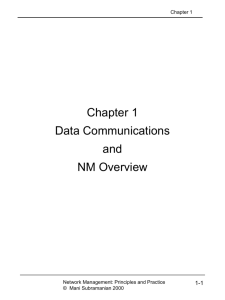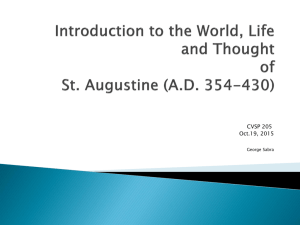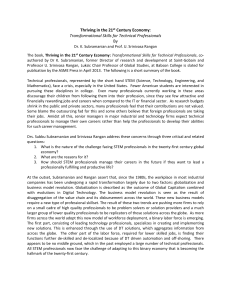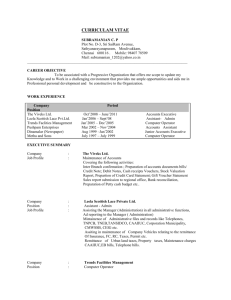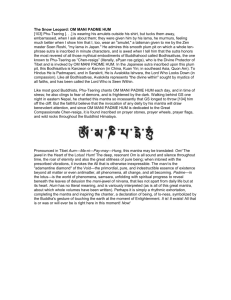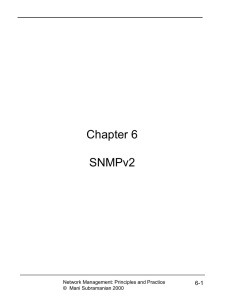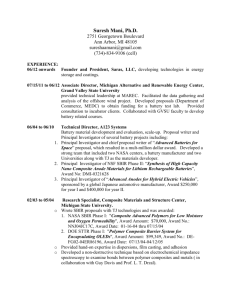NWM_ch_13
advertisement
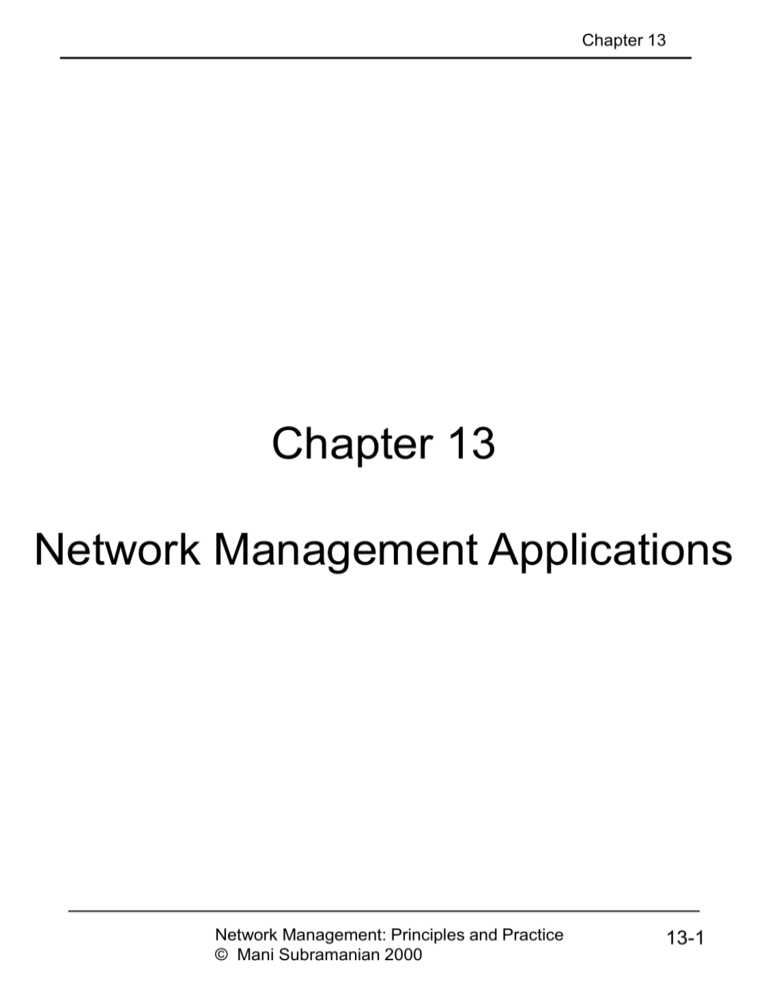
Chapter 13 Chapter 13 Network Management Applications Network Management: Principles and Practice © Mani Subramanian 2000 13-1 Chapter 13 Network and Systems Mgmt Business Management Service Management Network Management System Management Element Management Resource Management Network Elements System Resources Networked Information Systems Figure 13.1 Network and System Management Notes • TMN architecture expanded to include systems management Network Management: Principles and Practice © Mani Subramanian 2000 13-2 Chapter 13 Management Applications • OSI Model • Configuration • Fault • Performance • Security • Accounting • Reports • Service Level Management • Policy-based management Notes Network Management: Principles and Practice © Mani Subramanian 2000 13-3 Chapter 13 Configuration Management • Network Provisioning • Inventory Management • Equipment • Facilities • Network Topology • Database Considerations Notes Network Management: Principles and Practice © Mani Subramanian 2000 13-4 Chapter 13 Circuit Provisioning • Network Provisioning • Provisioning of network resources • Design • Installation and maintenance • Circuit-switched network • Packet-switched network, configuration for • Protocol • Performance • QoS • ATM networks Notes • Examples: • TIRKS (Trunk Integrated Record Keeping System) for circuit-switched networks • E1 in TIRKS for equipment management • F1 in TIRKS for facilities management Network Management: Principles and Practice © Mani Subramanian 2000 13-5 Chapter 13 Network Topology • Manual • Auto-discovery by NMS using • Broadcast ping • ARP table in devices • Mapping of network • Layout • Layering • Views • Physical • Logical Notes Network Management: Principles and Practice © Mani Subramanian 2000 13-6 Chapter 13 Traditional LAN Configuration Hub 1 Port A Segment A A1 A2 Router Port B Segment B B1 Hub 2 B2 Figure 13.2 LAN Physical Configuration A1 A2 Segment A / Hub 1 Router Segment B / Hub 2 B1 B2 Figure 13.3 Logical Configuration of Two LAN Segments Notes • One-to-one mapping between physical and logical configuration Network Management: Principles and Practice © Mani Subramanian 2000 13-7 Chapter 13 Virtual LAN Configuration Hub 1 Segment A A1 B1 Segment B Port A / Segment A Port A / Segment B Segment A Router Switch A2 Segment B Hub 2 B2 Figure 13.4 VLAN Physical Configuration A1 (Hub 1) A2 (Hub 2) Segment A / Hub 1 & 2 Router switch Segment B / Hub 1 & 2 B1 (Hub 1) B2 (Hub 2) Figure 13.5 Logical Configuration of Two VLAN Segments Notes • Physical and logical configurations different • Physical location obtained from System group Network Management: Principles and Practice © Mani Subramanian 2000 13-8 Chapter 13 Fault Management • Fault is a failure of a network component • Results in loss of connectivity • Fault management involves: • Fault detection • Polling • Traps: linkDown, egpNeighborLoss • Fault location • Detect all components failed and trace down the tree topology to the source • Fault isolation by network and SNMP tools • Use artificial intelligence / correlation techniques • Restoration of service • Identification of root cause of the problem • Problem resolution Notes Network Management: Principles and Practice © Mani Subramanian 2000 13-9 Chapter 13 Performance Management • Tools • Performance Metrics • Data Monitoring • Problem Isolation • Performance Statistics Notes • Tools: • Protocol analyzers • RMON • MRTG Network Management: Principles and Practice © Mani Subramanian 2000 13-10 Chapter 13 Performance Metrics • Macro-level • Throughput • Response time • Availability • Reliability • Micro-level • Bandwidth • Utilization • Error rate • Peak load • Average load Notes Network Management: Principles and Practice © Mani Subramanian 2000 13-11 Chapter 13 Traffic Flow Measurement Network Characterization International Backbones / National Regional / Midlevel Stub / Enterprise End-Systems / Hosts Figure 13.6 Traffic Flow Measurement Network Characterization Notes • Four levels defined by IETF (RFC 2063) • Three measurement entities: • Meters gather data and build tables • Meter readers collect data from meters • Managers oversee the operation • Meter MIB (RFC 2064) • NetrMet - an implementation(RFC 2123) Network Management: Principles and Practice © Mani Subramanian 2000 13-12 Chapter 13 Data Monitoring and Problem Isolation • Data monitoring • Normal behavior • Abnormal behavior (e.g., excessive collisions, high packet loss, etc) • Set up traps (e.g., parameters in alarm group in RMON on object identifier of interest) • Set up alarms for criticality • Manual and automatic clearing of alarms • Problem isolation • Manual mode using network and SNMP tools • Problems in multiple components needs tracking down the topology • Automated mode using correlation technology Notes Network Management: Principles and Practice © Mani Subramanian 2000 13-13 Chapter 13 Performance Statistics • Traffic statistics • Error statistics • Used in • QoS tracking • Performance tuning • Validation of SLA • Trend analysis • Facility planning • Functional accounting Notes Network Management: Principles and Practice © Mani Subramanian 2000 13-14 Chapter 13 Event Correlation Techniques • Basic elements • Detection and filtering of events • Correlation of observed events using AI • Localize the source of the problem • Identify the cause of the problem • Techniques • Rule-based reasoning • Model-based reasoning • Case-based reasoning • Codebook correlation model • State transition graph model • Finite state machine model Notes Network Management: Principles and Practice © Mani Subramanian 2000 13-15 Chapter 13 Rule-Based Reasoning Data Level Working Memory Create new data elements Recognize Modify attributes of data elements Remove data elements Inference Engine Match potential rules Select best rule Knowledge Level Act Control Level Invoke action Knowledge Level Figure 13.7 Basic Rule-Based Reasoning Paradigm Notes • Knowledge base contains expert knowledge on problem symptoms and actions to be taken if -> then condition -> action • Working memory contains topological and state information of the network; recognizes system going into faulty state • Inference engine in cooperation with knowledge base decides on the action to be taken • Knowledge executes the action Network Management: Principles and Practice © Mani Subramanian 2000 13-16 Chapter 13 Rule-Based Reasoning • Rule-based paradigm is an iterative process • RBR is “brittle” if no precedence exists • An exponential growth in knowledge base poses problem in scalability • Problem with instability if packet loss < 10% alarm green if packet loss => 10% < 15% alarm yellow if packet loss => 15% alarm red Solution using fuzzy logic Notes Network Management: Principles and Practice © Mani Subramanian 2000 13-17 Chapter 13 Configuration for RBR Example Server D1 Backbone Router A Alarm A Router B Alarm B Hub C Alarm C Server D2 Server D3 Server D4 Alarms Dx Figure 13.8 RBR-Based Correlation Example Scenario Notes Network Management: Principles and Practice © Mani Subramanian 2000 13-18 Chapter 13 RBR Example The correlation rule can be specified as follows: Rule 0: Alarm A : Send rootcause alarm A Rule 1 Alarm B If Alarm A present Related to A and ignore Rule 2 Alarm C If Alarm B present Related to B and ignore Rule 3 Alarm Dx if Alarm C present Related to C and ignore Correlation window: 20 seconds. Correlation window = 20 seconds Arrival of Alarm A | Alarm A sent Arrival of Alarm B | (Correlated by rule 1) Arrival of Alarm C | (Correlated by rule 2) Arrival of Alarms Dx (correlated by rule 3) End of correlation window | | Notes Network Management: Principles and Practice © Mani Subramanian 2000 13-19 Chapter 13 Model-Based Reasoning NMS / Correlator Backbone Network Router Model Router Hub1 Hub2 Physical Network Hub3 Hub1 Model Hub2 Model Hub3 Model Equivalent Model Figure 13.11 Model-Based Reasoning Event Correlator Notes • Object-oriented model • Model is a representation of the component it models • Model has attributes and relations to other models • Relationship between objects reflected in a similar relationship between models Network Management: Principles and Practice © Mani Subramanian 2000 13-20 Chapter 13 MBR Event Correlator Example: Hub 1 fails Recognized by Hub 1 model Hub 1 model queries router model Router model declares failure Hub 1 model declares NO failure Router model declares no failure Hub 1 model declares Failure Notes Network Management: Principles and Practice © Mani Subramanian 2000 13-21 Chapter 13 Case-Based Reasoning Case Library Input Retrieve Adapt Process Figure 13.12 General CBR Architecture Notes • Unit of knowledge • RBR rule • CBR case • CBR based on the case experienced before; extend to the current situation by adaptation • Three adaptation schemes • Parameterized adaptation • Abstraction / re-specialization adaptation • Critic-based adaptation Network Management: Principles and Practice © Mani Subramanian 2000 13-22 Chapter 13 CBR: Matching Trouble Ticket Example: File transfer throughput problem Trouble: file_transfer_throughput=F Additional data: none Resolution: A=f(F), adjust_network_load=A Resolution status: good Figure 13.13 Matching Trouble Ticket Notes • Trouble ticket in case library: A = f(F) • Parameter A is a function of Parameter F Network Management: Principles and Practice © Mani Subramanian 2000 13-23 Chapter 13 CBR: Parameterized Adaptation Trouble: file_transfer_throughput=F' Additional data: none Resolution: A'=f(F'), adjust_network_load=A' Resolution status: good Figure 13.14 Parameterized Adaptation Notes • A = f(F) • A’ = f(F’) • Functional relationship f(x) remains the same Network Management: Principles and Practice © Mani Subramanian 2000 13-24 Chapter 13 CBR: Abstraction / Re-specialization Trouble: file_transfer_throughput=F Additional data: none Resolution: A=f(F), adjust_network_load=A Resolution status: good Trouble: file_transfer_throughput=F Additional data: none Resolution: B=g(F), adjust_network_bandwidth=B Resolution status: good Trouble: file_transfer_throughput=F Additional data: adjust_network_load=no Resolution: B=g(F), adjust_network_bandwidth=B Resolution status: good Figure 13.15 Abstraction / Re-specialization Adaptation Notes • Two possible resolutions • A = f(F) Adjust network load level • B = g(F) Adjust bandwidth • Resolution based on constraint imposed Network Management: Principles and Practice © Mani Subramanian 2000 13-25 Chapter 13 CBR: Critic-Based Adaptation Trouble: file_transfer_throughput=F Additional data: network_load=N Resolution: A=f(F,N), adjust_network_load=A Resolution status: good Figure 13.16 Critic-Based Adaptation Notes • Human expertise introduces a new case • N (network load) is an additional parameter added to the functional relationship Network Management: Principles and Practice © Mani Subramanian 2000 13-26 Chapter 13 CBR-Based Critter Network Spectrum Configuration Management Fault Detection CRITTER Fault Management Fault Resolution Case Library Input Retrieve Determinators Adapt Application Techniques Propose Process User-based Adaptation User Figure 13.17 CRITTER Architecture Notes • CRITTER is CBR-based trouble resolution system • Integrated with Cabletron Spectrum NMS • “Propose” is additional (5th) module to CBR architecture; permits manual intervention Network Management: Principles and Practice © Mani Subramanian 2000 13-27 Chapter 13 Codebook Correlation Model: Generic Architecture Configuration Model Event Model Correlator Network Problems Monitors Notes • Yemini, et.al. proposed this model • Monitors capture alarm events • Configuration model contains the configuration of the network • Event model represents events and their causal relationships • Correlator correlates alarm events with event model and determines the problem that caused the events Network Management: Principles and Practice © Mani Subramanian 2000 13-28 Chapter 13 Codebook Approach Approach: • Correlation algorithms based upon coding approach to even correlation • Problem events viewed as messages generated by a system and encoded in sets of alarms • Correlator decodes the problem messages to identify the problems Two phases: 1. Codebook selection phase: Problems to be monitored identified and the symptoms they generate are associated with the problem. This generates codebook (problem-symptom matrix) 2. Correlator compares alarm events with codebook and identifies the problem. Notes Network Management: Principles and Practice © Mani Subramanian 2000 13-29 Chapter 13 Causality Graph E4 E5 E6 E1 E2 E3 E7 Figure 13.19 Causality Graph Notes • Each node is an event • An event may cause other events • Directed edges start at a causing event and terminate at a resulting event • Picture causing events as problems and resulting events as symptoms Network Management: Principles and Practice © Mani Subramanian 2000 13-30 Chapter 13 Labeled Causality Graph S1 S2 S3 P1 P2 P3 S4 Figure 13.20 Labeled Causality Graph for Figure 13.19 Notes • Ps are problems and Ss are symptoms • P1 causes S1 and S2 • Note directed edge from S1 to S2 removed; S2 is caused directly or indirectly (via S1) by P1 • S2 could also be caused by either P2 or P3 Network Management: Principles and Practice © Mani Subramanian 2000 13-31 Chapter 13 Codebook S1 S2 S3 S4 P1 1 1 0 0 P2 1 1 1 0 P3 0 1 1 1 Notes • Codebook is problem-symptom matrix • It is derived from causality graph after removing directed edges of propagation of symptoms • Number of symptoms => number of problems • 2 rows are adequate to identify uniquely 3 problems Network Management: Principles and Practice © Mani Subramanian 2000 13-32 Chapter 13 Correlation Matrix S1 S3 P1 1 0 P2 1 1 P3 0 1 Notes • Correlation matrix is reduced codebook Network Management: Principles and Practice © Mani Subramanian 2000 13-33 Chapter 13 Correlation Graph S1 P1 S3 P2 P3 Figure 13.23 Correlation Graph for Figure 13.20 Notes • Correlation graph is derived from correlation matrix Network Management: Principles and Practice © Mani Subramanian 2000 13-34 Chapter 13 Generalized Causality Graph 9 10 11 5 8 7 6 3 1 4 2 (a) Event Causality Graph Notes • Causality graph has 11 events - problems and symptoms • Mark all nodes that have only emerging directed edges as problems - Nodes 1, 2, and 11 • Other nodes are symptoms Network Management: Principles and Practice © Mani Subramanian 2000 13-35 Chapter 13 P-S Causality Graph S S S 9 10 P 11 5 8 7 S 6 3 4 S S 1 2 P P (b) Problem-Symptom Causality Graph Notes • To reduce causality graph to correlation graph: • Symptoms 3, 4, and 5 are cyclical: replace with one symptom, say 3 • S7 and S10 are caused by S3 and S5 and hence ignored • S8 causes S9. Keep S9 and eliminate S8; reason for this would be more obvious if we go through reduction of codebook to correlation matrix Network Management: Principles and Practice © Mani Subramanian 2000 13-36 Chapter 13 Correlation Graph and Matrix 9 3 6 1 11 2 Figure 13.25 Correlation Graph Notes S3 S6 S9 P1 1 0 1 P2 1 1 0 P11 1 0 1 Correlation Matrix • Note that problems 1 and 11 produce identical symptoms Network Management: Principles and Practice © Mani Subramanian 2000 13-37 Chapter 13 Codebook Enhancements • Codebook described so far assumes Hamming distance of 1 for uniqueness • Noise affects accuracy • Increase Hamming distance to >1 • Probability of a problem causing a symptom assumed as 1. It can be made Si = Pr(Pj) to be more realistic Notes Network Management: Principles and Practice © Mani Subramanian 2000 13-38 Chapter 13 State Transition Model ping node response ping receive response Figure 13.27 State Transition Diagram for Ping / Response Notes • Used in Seagate’s NerveCenter correlation system • Integrated in NMS, such as OpenView • Used to determine the status of a node Network Management: Principles and Practice © Mani Subramanian 2000 13-39 Chapter 13 State Transition Model Example NMS / Correlator Backbone Network Router Hub1 Hub2 Hub3 Physical Network Notes • NMS pings hubs every minute • Failure indicated by the absence of a response Network Management: Principles and Practice © Mani Subramanian 2000 13-40 Chapter 13 State Transition Graph ping hub response ping receive response No response pinged twice (Ground state) No response pinged 3 times No response Request No response from Router, No action receive response from router ping router Response Response received from Router Action: Send Alarm Figure 13.28 State Transition Graph Example Network Management: Principles and Practice © Mani Subramanian 2000 13-41 Chapter 13 Finite State Machine Model Client Server Request Message Send Request Response Request Receive Response Communication Channel Response Message Receive Request Send Receive Send Response Figure 13.29 Communicating Finite State Machine Notes • Finite state machine model is a passive system; state transition graph model is an active system • An observer agent is present in each node and reports abnormalities, such as a Web agent • A central system correlates events reported by the agents • Failure is detected by a node entering an illegal state Network Management: Principles and Practice © Mani Subramanian 2000 13-42 Chapter 13 Security Management • Security threats • Policies and Procedures • Resources to prevent security breaches • Firewalls • Cryptography • Authentication and Authorization • Client/Server authentication system • Message transfer security • Network protection security Notes Network Management: Principles and Practice © Mani Subramanian 2000 13-43 Chapter 13 Security Threats Modification of information Masquerade Message stream modification Management Entity A Management Entity B Disclosure Figure 7.10 Security Threats to Management Information Notes • SNMPv3 addressed security threats using USM (user-based security model) • USM has two modules: • Authentication module • Data integrity • Data origin • Privacy module • Data confidentiality • Message timeliness • Message protection Network Management: Principles and Practice © Mani Subramanian 2000 13-44 Chapter 13 Policies and Procedures Basic guidelines to set up policies and procedures: 1. Identify what you are trying to protect. 2. Determine what you are trying to protect it from. 3. Determine how likely the threats are. 4. Implement measures, which will protect your assets in a cost-effective manner. 5. Review the process continuously and make improvements to each item if a weakness is found. Notes • References: • Formal statement of rules for protecting organization’s technology and assets (RFC 2196) • Introduction to Firewalls (NIST) • Orange Book by National Computer Security Center (NCSC) rates computers based on security design features Network Management: Principles and Practice © Mani Subramanian 2000 13-45 Chapter 13 Secured Communication Network Client A Firewall Gateway Secured Network A Client B Router Network B Server A Figure 13.30 Secured Communication Network Notes • Firewall secures traffic in and out of Network A • Security breach could occur by intercepting the message going from B to A, even if B has permission to access Network A • Most systems implement authentication with user id and password • Authorization is by establishment of accounts Network Management: Principles and Practice © Mani Subramanian 2000 13-46 Chapter 13 Firewalls • Protects a network from external attacks • Controls traffic in and out of a secure network • Could be implemented in a router, gateway, or a special host • Benefits • Reduces risks of access to hosts • Controlled access • Eliminates annoyance to the users • Protects privacy (e.g. finger) • Hierarchical implementation of policy and and technology (e.g. finger) Notes Network Management: Principles and Practice © Mani Subramanian 2000 13-47 Chapter 13 Packet Filtering Firewall Trash Ethernet SMTP Gateway FTP Gateway Packet Filtering Router Internet Screened SMTP & FTP Secured Network Figure 13.31 Packet Filtering Router Notes • Uses protocol specific criteria at DLC, network, and transport layers • Implemented in routers - called screening router or packet filtering routers • Filtering parameters: • Source and/or destination IP address • Source and/or destination TCP/UDP port address, such as ftp port 21 • Multistage screening - address and protocol • Works best when rules are simple Network Management: Principles and Practice © Mani Subramanian 2000 13-48 Chapter 13 Application Level Gateway Secured Network Firewall 1 Secured LAN Firewall 2 Internet Proxy Services Application Gateway Figure 13.32 Application Level Gateway Notes • Firewalls 1 and 2 route traffic only from and to the secured LAN • Secured LAN is gateway LAN • Behavior of application gateway dependent on the application • FTP traffic stored and forwarded after validation • TELNET hosts validated for the session and then direct communication established Network Management: Principles and Practice © Mani Subramanian 2000 13-49 Chapter 13 Cryptography • Secure communication requires • Integrity protection: ensuring that the message is not tampered with • Authentication validation: ensures the originator identification • Security threats • Modification of information • Masquerade • Message stream modification • Disclosure • Hardware and software solutions • Most secure communication is software based Notes Network Management: Principles and Practice © Mani Subramanian 2000 13-50 Chapter 13 Secret Key Cryptography Transmission Channel Ciphertext Decryption Plaintext Secret Key Encryption Secret Key Plaintext Figure 13.33 Basic Cryptographic Communication Notes • Caesar cipher: each letter replaced by another letter, which is three letters behind in the alphabet • Maximum of 26 attempts to decode Caesar cipher • Monoalphabetic cipher: Replace a letter with another randomly chosen; Maximum attempts to decode 26! • One secret key is needed between each pair • Two standard algorithms for secret key: • DES (Data Encryption Standard): 64-bit message blocks and 56-bit key • IDEA (International Data Encryption Algorithm): 64-bit message blocks and 128-bit key • Message block derived using CBC (Cipher Block Chaining) • Principle based on rearranging the blocks several times based on predetermined algorithm and secret key Network Management: Principles and Practice © Mani Subramanian 2000 13-51 Chapter 13 Public Key Cryptography Transmission Channel Ciphertext Decryption Plaintext Private Key Encryption Public Key Plaintext Figure 13.34 Public Key Cryptographic Communication Notes • Asymmetric cryptography - public and private key • Public key is distributed by the receiver to the senders to encrypt the message. • Private key is used by receiver to decode ciphertext • Mailbox analogy • Commonly used public key is RSA (Rivest, Shamir, and Adleman); 512-bit key, variable block size • RSA less efficient than DES and IDEA; used to encrypt secret key Network Management: Principles and Practice © Mani Subramanian 2000 13-52 Chapter 13 Message Digest • Message digest is a cryptographic hash algorithm added to a message • One-way function • Analogy with CRC • If the message is tampered with the message digest at the receiving end fails to validate • MD5 (used in SNMPv3) commonly used MD • MD5 takes a message of arbitrary length (32-Byte) blocks and generates 128-bit message digest • SHS (Secured Hash Standard) message digest proposed by NIST handles 264 bits and generates 160-bit output Notes Example: $ md5 The quick brown fox jumped over the lazy dog ^D d8e8fca2dc0f896fd7cb4cb0031ba249 Network Management: Principles and Practice © Mani Subramanian 2000 13-53 Chapter 13 Rita's Public Key (R) Ian's Private Key (S) Encryption Plaintext Plaintext Signed Ciphertext Decryption Signature Validation Ian's Public Key (S) Digital Signature Transmission Channel Rita's Private Key (R) Plaintext Plaintext Digital Signature Figure 13.37 Signed Public Key Cryptographic Communication Notes • Why do we need digital signature? • Principle reverse of public key • Signature created using private key and validated using public key • Digital signature is a message digest generated from plaintext and private key by a hashing algorithm • Digital signature is concatenated with the plaintext and encrypted using public key Network Management: Principles and Practice © Mani Subramanian 2000 13-54 Chapter 13 Authentication and Authorization • Authentication verifies user identification • Client/server environment • Ticket-granting system • Authentication server system • Cryptographic authentication • Messaging environment • e-mail • e-commerce • Authorization grants access to information • Read, read-write, no-access • Indefinite period, finite period, one-time use Notes Network Management: Principles and Practice © Mani Subramanian 2000 13-55 Chapter 13 Ticket-Granting System Kerberos User Input Client Workstation Application Server / Service Authentication Server TicketGranting Server Figure 13.38 Ticket-Granting System Notes • Used in client/server authentication system • Kerberos developed by MIT • Steps: • User logs on to client workstation • Login request sent to authentication server • AS checks ACL, grants encrypted ticket to client • Client obtains from TGS service-granting ticket and session key • Appl. Server validates ticket and session key, and then provides service Network Management: Principles and Practice © Mani Subramanian 2000 13-56 Chapter 13 Authentication Server User Input Client Workstation Authentication Authentication Server Proxy Server Service Application Server / Service Authentication Figure 13.39 Authentication Server Notes • Architecture of Novell LAN • Authentication server does not issue ticket • Login and password not sent from client workstation • User sends id to central authentication server • Authentication server acts as proxy agent to the client and authenticates the user with the application server • Process transparent to the user Network Management: Principles and Practice © Mani Subramanian 2000 13-57 Chapter 13 Message Transfer Security • Messaging one-way communication • Secure message needs to be authenticated and secured • Three secure mail systems • Privacy Enhanced Mail (PEM) • Pretty Good Privacy (PGP) • X-400: OSI specifications that define framework; not implementation specific Notes Network Management: Principles and Practice © Mani Subramanian 2000 13-58 Chapter 13 Privacy Enhanced Mail • Developed by IETF (RFC 1421 - 1424) • End-to-end cryptography • Provides • Confidentiality • Authentication • Message integrity assurance • Nonrepudiation of origin • Data encryption key (DEK) could be secret or public key-based originator and receiver agreed upon method • PEM processes based on cryptography and message encoding • MIC-CLEAR (Message Integrity Code-CLEAR) • MIC-ONLY • ENCRYPTED Notes Network Management: Principles and Practice © Mani Subramanian 2000 13-59 Chapter 13 PEM Processes (Originating end) MIC Encrypted DEK Text SMTP Format Conversion SMTP Text MIC Generator MIC-CLEAR PEM MIC/DEK e-mail System IK DEK User Plaintext MIC Encrypted DEK (a) MIC-CLEAR PEM Process Encoded Text MIC/DEK SMTP Format Conversion SMTP Text Encoder (Printable code) MIC Generator MIC ONLY PEM IK DEK User Plaintext e-mail System MIC Encrypted DEK (b) MIC-ONLY PEM Process Encrypted & Encoded Message MIC/DEK Legend: DEK Data Encryption Key IK Interexchange Key MIC Message Integrity Code SMTP Simple Mail Transfer Protocol MIC Generator Padding & Encryption Encoder (Printable code) ENCRYPTED PEM e-mail System IK SMTP Text DEK SMTP Format Conversion DEK User Plaintext (c) ENCRYPTED PEM Process Figure 13. 40 PEM Processes Notes • DEK a random number generated per message basis: used to encrypt the message text and generate MIC • IK a long-range key agreed upon between the sender receiver used to encrypt DEK: IK is either public or secret • Public key avoids repudiation Network Management: Principles and Practice © Mani Subramanian 2000 13-60 Chapter 13 Public Key Pretty Good Privacy Plaintext Encryption (Originating end) Encrypted & Compressed Message Compression Concatenation e-mail conversion e-mail system Signature Generation Private Key Plaintext Signature Figure 13.41 PGP Process Notes • PGP secure mail package developed by Zimmerman • Available in public domain • Signature generation • Uses MD5 to generate hash code • Encrypts hash code with sender’s private key using RSA algorithm • Encryption of the message done using IDEA or RSA • Compression done with ZIP • e-mail conversion done using Radix-64 • PGP similar to encrypted PEM with added compression Network Management: Principles and Practice © Mani Subramanian 2000 13-61 Chapter 13 SNMPv3 Security (Outgoing message) Encrypted scopedPDU scopedPDU Encryption Key password authoritativeSnmpEngineId Privacy Module USM wholeMsg authKey HMAC Gen. Authentication Module authenticated wholeMsg USM Figure 13.42 SNMP Secure Communication Notes • Authentication key equivalent to DEK in PEM or private key in PGP • Authentication key generated using user password and SNMP engine id • Authentication key may be used to encrypt message • USM prepares the whole message including scoped PDU • HMAC, equivalent of signature in PEM and PGP, generated using authentication key and the whole message • Authentication module provided with authentication key and HMAC to process incoming message Network Management: Principles and Practice © Mani Subramanian 2000 13-62 Chapter 13 Virus Attacks • Executable programs that make copies and insert them into other programs • Attacks hosts and routers • Attack infects boot track, compromises cpu, floods network traffic, etc. • Prevention is by identifying the pattern of the virus and implementing protection in virus checkers Notes Network Management: Principles and Practice © Mani Subramanian 2000 13-63 Chapter 13 Accounting Management • Least developed • Usage of resources • Hidden cost of IT usage (libraries) • Functional accounting • Business application Notes Network Management: Principles and Practice © Mani Subramanian 2000 13-64 Chapter 13 Report Management Table 13.1 Planning and Management Reports Category Quality of service / Service level agreement Traffic trends Technology trends Cost of Operations Reports Network availability Systems availability Problem reports Service response Customer satisfaction Traffic patterns Analysis of internal traffic volume Analysis of external traffic volume Current status Technology migration projection Functional Usage Personnel Table 13.2 System Reports Category Traffic Failures Performance Reports Traffic load - internal Traffic load - external Network failures System failures Network Servers Applications Table 13.3 User Reports Category Service level agreement User specific reports Reports Network availability System availability Traffic load Performance User-defined reports Network Management: Principles and Practice © Mani Subramanian 2000 13-65 Chapter 13 Policy-Based Management Network Attributes Policy Space Domain Space Policy Driver Action Space Rule Space Figure 13.43 Policy Management Architecture Notes • Domain space consists of objects (alarms with attributes) • Rule space consists of rules (if-then) • Policy Driver controls action to be taken • Distinction between policy and rule; policy assigns responsibility and accountability • Action Space implements actions Network Management: Principles and Practice © Mani Subramanian 2000 13-66 Chapter 13 Service Level Management • SLA management of service equivalent to QoS of network • SLA defines • Identification of services and characteristics • Negotiation of SLA • Deployment of agents to monitor and control • Generation of reports • SLA characteristics • Service parameters • Service levels • Component parameters • Component-to-service mappings Notes Network Management: Principles and Practice © Mani Subramanian 2000 13-67
